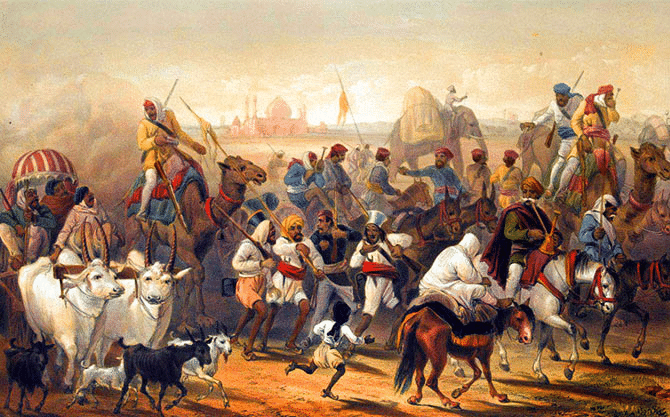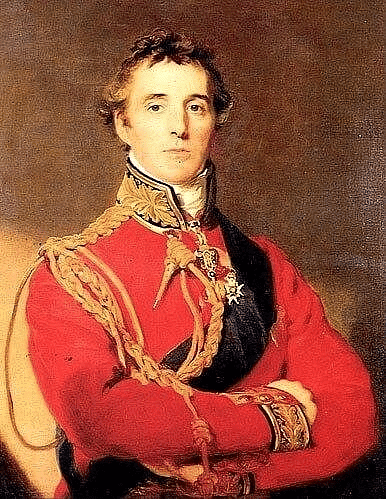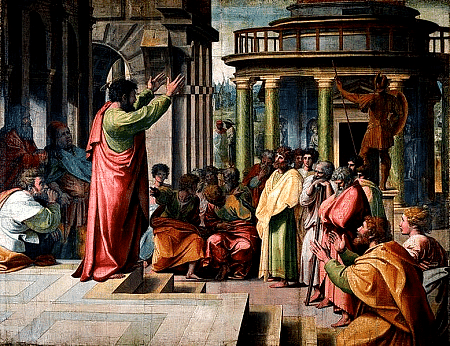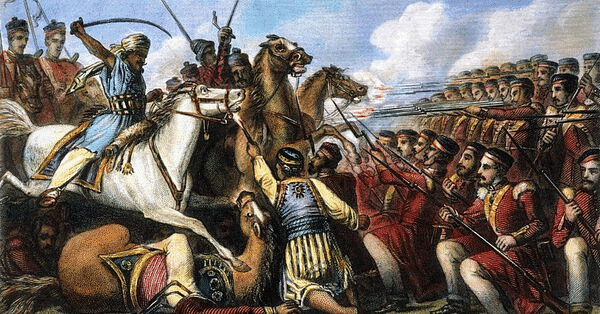Old NCERT Summary (Bipan Chandra): The Revolt of 1857- 1 | History for UPSC CSE PDF Download
Understanding the Revolt of 1857
The Revolt of 1857 was a significant event in Indian history that took place in Northern and Central India. It was a widespread uprising against British rule that began with a mutiny of Indian soldiers but quickly spread to involve millions of people from various sections of society.
 The Revolt of 1857
The Revolt of 1857
Causes of the Revolt
- Economic Exploitation: One of the main reasons behind the discontent was the economic exploitation by the British. The traditional economic structure of India was severely affected, leading to the impoverishment of peasants, artisans, and others.
- Land and Revenue Policies: British land and revenue policies were detrimental to many peasant proprietors who lost their lands to money-lenders. This economic strain pushed many into debt.
- Corruption in Administration: The widespread corruption at lower levels of administration, including the police, officials, and law courts, added to the dissatisfaction among the common people.
Impact on Society
- Effect on Middle and Upper Classes: The middle and upper classes, especially in the North, faced challenges due to their exclusion from well-paid administrative positions. The disappearance of Indian states also affected those employed in high posts.
- Impact on Cultural Pursuits: The supremacy of the British had negative consequences for individuals engaged in cultural activities, leading to their ruin.
General Discontent and Revolt
- The general discontent among various sections of society, fueled by grievances against the foreign rule and the British administration, culminated in a widespread revolt that aimed to improve the conditions of the people.
- The growing poverty and desperation of the masses pushed them towards participating in the revolt as a means of seeking a better life.
Unpopularity of British Rule in India
The British rule in India faced widespread discontent and opposition for various reasons, leading to a significant uprising in 1857. Let's break down the key factors contributing to this sentiment:
Withdrawal of Patronage and Foreignness of British Rule
- The displacement of Indian rulers by the East India Company resulted in the abrupt cessation of support for arts, culture, and religious figures. This sudden withdrawal of patronage left many dependent individuals impoverished.
- Religious preachers, pandits, and maulvis, feeling threatened by the loss of patronage, started spreading hatred against the foreign British rule.
- The British rule was perceived as highly foreign. British officials maintained a social and racial distance from Indians, fostering a sense of superiority and treating locals with disdain.
- Unlike previous conquerors who integrated with local elites, the British aimed to enrich themselves and return to Britain, not making India their permanent home. This lack of commitment fueled suspicions and anti-British sentiments among Indians.
Loss of Invincibility and Rising Discontent
- Major British military defeats in the First Afghan War, Punjab Wars, and Crimean War shattered the myth of British invincibility, leading Indians to believe in the eventual decline of British dominance.
- The successful uprising of the Santhal tribesmen in 1855-56 highlighted the potential for popular resistance against British rule, even using primitive weapons like axes and bows.
- Despite British victories in these conflicts, the perception of their vulnerability encouraged Indians to believe in the possibility of overcoming British rule through determined resistance.
Significance of Confidence in Rebellion
People do not revolt merely out of a desire to overthrow rulers; they must also believe in their ability to succeed. The miscalculation of British strength by Indian rebels in 1857 proved costly.
Confidence in the potential success of a rebellion is crucial for sparking and sustaining mass uprisings against ruling powers.
Annexation of Avadh by Lord Dalhousie in 1856
The annexation of Avadh by Lord Dalhousie in 1856 caused widespread discontent in India, particularly in Avadh. This action led to a sense of rebellion among the people of Avadh and the Company's army, especially angering the Company's sepoys, many of whom hailed from Avadh.
 Lord Dalhousie
Lord Dalhousie
Reasons for Discontent:
- The sepoys, while lacking a unified national sentiment, harbored strong regional and local loyalties. They had previously assisted the British in conquering other parts of India but were displeased by their homeland falling under foreign rule.
- The annexation of Avadh had adverse economic impacts on the sepoys, as they now had to bear higher taxes on the land owned by their families in Avadh.
Effects of Annexation:
- The purported reason for annexing Avadh was to alleviate the oppression by the Nawab and taluqdars. However, in reality, the common people did not experience any relief.
- Post-annexation, the common folk faced increased land revenue, additional taxes on various essentials, and a transfer of land from traditional landowners to new zamindars and money-lenders.
- The dissolution of the Nawab's administration and army resulted in widespread unemployment among nobles, officials, soldiers, and others, creating economic instability.
- Merchants, shopkeepers, and artisans who relied on the patronage of the Avadh Court and nobles lost their livelihoods without any alternative employment opportunities provided by the British.
Political Ramifications:
- The annexation of Avadh, alongside other actions by Dalhousie, instilled fear among rulers of native states, as they realized that even staunch loyalty did not deter British territorial ambitions.
- The British's repeated breaches of treaties and promises tarnished their political reputation, leading to the alienation and enmity of key figures like Nana Sahib, the Rani of Jhansi, and Bahadur Shah.
The policy of annexation significantly impacted the relationships between the British and Indian powers, resulting in the alienation of once loyal figures and the erosion of British political credibility in the region.
Role of Christian Missionaries in Turning People Against British Rule
In the fight against British rule, the fear that it posed a threat to their religion was a significant factor. This fear was largely fueled by the actions of Christian missionaries who were actively trying to convert people and openly criticizing Hinduism and Islam.
Activities of Christian Missionaries
- Christian missionaries were widespread, visible in schools, hospitals, prisons, and markets.
- They attempted to convert people and launched aggressive attacks on Hinduism and Islam.
- They mocked and condemned the traditional customs and practices of the people.
- They were backed by police protection, which added to the people's concerns.
Government Support and Suspicion
- In 1850, a law was passed allowing Christian converts to inherit ancestral property, which furthered suspicions.
- The government funded chaplains in the army, leading to a perception of official endorsement of Christianity.
- Officials, both civil and military, actively promoted missionary work and Christian teachings in government institutions.
Impact on the People
- The activities of these missionaries and government officials instilled fear among the population.
- People felt that their religion was under threat, especially when they witnessed conversions to Christianity.
- Reports of government support for missionary activities added to the prevailing suspicions.
Religious, Social, and Economic Causes of the Revolt of 1857
In the mid-19th century, a significant uprising known as the Revolt of 1857 took place in India. This revolt was fueled by a combination of religious, social, and economic factors that led to a widespread rebellion against British colonial rule. Let's break down the key points of this historical event:
Religious Sentiments and Government Policies
- The British government's attempts to introduce Christian missionary activities and reforms in India sparked resentment among the local population.
- Measures like the abolition of Sati (the practice of widow immolation), legalization of widows' remarriage, and promotion of Western education for girls were seen as unwanted interference in traditional practices.
- Taxation of lands belonging to temples and mosques, previously exempted by Indian rulers, further angered religious communities.
Sepoys and Social Unrest
- The mutiny of the Company's sepoys, Indian soldiers serving under British command, marked the beginning of the revolt.
- Sepoys, being part of Indian society, shared the grievances and aspirations of the wider population.
- Economic hardships, religious concerns, and suspicions of British intentions to convert Indians to Christianity fueled their discontent.
- Restrictions on religious practices, such as forbidding caste and sectarian markings, also contributed to their dissatisfaction.
- An Act in 1856 requiring sepoys to serve overseas, violating religious beliefs that prohibited sea travel, added to their sense of betrayal.
British Influence and Propaganda
British officers' efforts to promote Christianity among sepoys and the presence of chaplains in the army deepened suspicions of religious interference.
The perception that the British sought to undermine Indian religions fueled resentment and resistance.
These factors, combined with economic disparities and social injustices, culminated in a widespread revolt against British rule.
Impact of Christian Missionaries on Indian Society during British Rule
In the era of British colonial rule in India, the presence of Christian missionaries significantly influenced the perceptions and fears of the Indian population. The missionaries' activities led to a deep-seated fear among the people that their religion was under threat, thereby contributing to the anti-British sentiment.
 Christian Missionaries
Christian Missionaries
Activities of Christian Missionaries
- Christian missionaries were omnipresent, being visible in schools, hospitals, prisons, and markets.
- They actively attempted to convert people and conducted aggressive public condemnations of Hinduism and Islam.
- They openly mocked and criticized the traditional customs and practices of the Indian people.
- The missionaries were backed by police protection, which added to the perception of their association with the British authorities.
Government Support and Suspicions
- The British government passed a law in 1850 allowing converts to Christianity to inherit ancestral property, which raised suspicions among the populace.
- Chaplains and Christian priests were funded by the government within the army, further indicating official support for missionary activities.
- Several civil and military officials actively promoted Christian teachings in government schools and prisons, instilling fear among the local population.
Impact on Indian Society
- The activities of missionaries and government officials instilled a sense of fear and suspicion among the Indian people.
- The conversions carried out by missionaries were perceived as evidence of the threat posed to traditional religions.
- The perceived alignment between the British government and missionary efforts deepened the apprehensions of the Indian populace.
Religious, Cultural, and Sepoy Grievances Leading to the Revolt of 1857
In the mid-19th century, the Revolt of 1857, also known as the Indian Mutiny or the First War of Independence, was a significant uprising against British rule in India. Let's break down the reasons behind this historic event:
Religious and Cultural Factors
- The British government's initiatives such as the abolition of Sati (the practice of widow immolation), legalization of widows' remarriage, and introduction of Western education for girls were seen as unwanted interference in Indian traditions and beliefs.
- Taxation on lands belonging to temples, mosques, and charitable institutions led to resentment among Brahmin and Muslim families who depended on them, fueling the perception that British rule aimed to undermine Indian religions.

Sepoys' Grievances and Religious Tensions
- The sepoys, Indian soldiers serving the British East India Company, felt the economic hardships faced by their families due to British policies, including the belief that the British were trying to convert Indians to Christianity.
- Restrictions on religious practices, such as forbidding the wearing of caste and sectarian marks, beards, or turbans, and the requirement for overseas service, which conflicted with Hindu religious beliefs, added to their discontent.
Propaganda and Cultural Insensitivity
- British officers' efforts to spread Christianity among the sepoys, along with the presence of chaplains paid for by the state within the army, contributed to the perception that the British were disrespecting Indian religions.
- The passing of laws that clashed with Indian religious norms, like the prohibition on sea travel which was considered impure by Hindus, deepened the rift between the sepoys and the British authorities.
- During the period of British rule in India, the sepoys, who were Indian soldiers serving under British command, had various complaints against their British officers and employers. These grievances stemmed from mistreatment, discrimination, and unfavorable working conditions.
Sepoy Treatment by British Officers
- The British officers treated the sepoys with disrespect and contempt.
- They were considered inferior beings and were subjected to verbal abuse, rough treatment, and derogatory terms like "nigger," "suar," or "pig."
- Despite being skilled soldiers like their British counterparts, sepoys received significantly lower pay and poor living conditions.
- There was little to no opportunity for career advancement, with a cap on promotions and salaries.
Immediate Causes of Dissatisfaction
- A recent directive eliminating foreign service allowances for sepoys serving in specific regions led to a significant reduction in their salaries.
- The annexation of Avadh, a region where many sepoys hailed from, further fueled their discontent.
Historical Context of Sepoy Dissatisfaction
- Instances of sepoys rebelling against British authority date back to as early as 1764 in Bengal.
- Revolts occurred in Vellore in 1806, Barrackpore in 1824, and various other locations due to issues related to salaries and allowances.
- During the Afghan War, sepoys on the brink of rebellion were met with severe consequences, including executions.
- The widespread discontent among sepoys was acknowledged by officials, with warnings of potential mutinies due to accumulated grievances.
|
122 videos|653 docs|168 tests
|
FAQs on Old NCERT Summary (Bipan Chandra): The Revolt of 1857- 1 - History for UPSC CSE
| 1. What were the main causes of the Revolt of 1857? |  |
| 2. How did the Revolt of 1857 impact the British rule in India? |  |
| 3. What role did sepoys play in the Revolt of 1857? |  |
| 4. How did the Revolt of 1857 impact the Indian society and culture? |  |
| 5. What were the long-term consequences of the Revolt of 1857 on the Indian freedom struggle? |  |






















